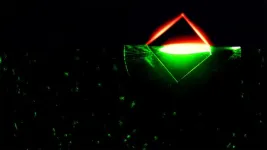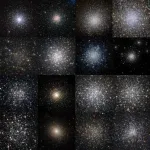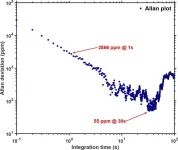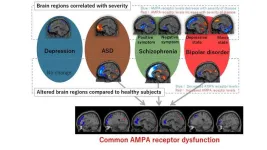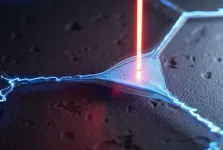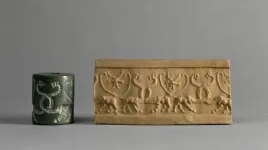(Press-News.org) SAN ANTONIO — November 5, 2024 —Southwest Research Institute’s Dr. James Walker has received the Distinguished Scientist Award from the Hypervelocity Impact Society. This honor recognizes individuals who have made a significant and lasting contribution to the field of hypervelocity science. Hypervelocity impact is typically viewed as impacts at speeds above 2 kilometers per second (4,475 miles per hour); for some materials, however, lower speed impacts display hypervelocity impact effects.
The award cited Walker’s research and wide-ranging applications in penetration modeling. These include developing a technique to launch fragments at over 10 kilometers per second and conducting launch safety evaluations for the New Horizons spacecraft’s radioisotope thermoelectric generator. Walker also led performed modeling work during the Space Shuttle Columbia accident investigation and authored the technical appendix on the foam impact on the wing leading edge in the Columbia Accident Investigation Report.
“This is a great honor,” Walker said. “Since the award’s inception in 1989, only 17 people have received this award, and three of them have been from SwRI. It shows the strength of our hypervelocity impact program, and it’s exciting to see it receive this kind of recognition.”
Walker joined SwRI as a postdoctoral fellow in 1988. His impact-focused research includes applications in body armor, ground vehicle armor, ballistic and blast protection for the Navy’s next-generation destroyer (DDG-1000 Zumwalt) and shielding against hypervelocity impact by orbital debris for the International Space Station. Along with SwRI retiree Dr. Charles Anderson, he developed the Walker-Anderson model, a widely used analytical penetration model that provides a fast-running, accurate estimation of the penetration performance of metallic, ceramic and fabric armors.
After the Space Shuttle Columbia accident in 2003, Walker supported NASA’s investigation of the incident and the return to flight program that followed. NASA used his models in its risk analyses to help determine that the Space Shuttle program was ready to return to flight in 2005.
He recently served as a member of the investigation team for NASA’s Double Asteroid Redirection Test (DART), a planetary defense mission designed to assess whether an impact could redirect an asteroid on a collision course with Earth. The mission deliberately crashed a spacecraft into the asteroid Dimorphos, successfully altering its trajectory. This follows and extends Walker’s work in planetary defense, protecting Earth from asteroids and comets, and momentum enhancement. Walker’s book Modern Impact and Penetration Mechanics was published in 2021 by Cambridge University Press.
Walker previously served as the president of the Hypervelocity Impact Society and on its board of directors. He is the current president of the International Ballistics Society (IBS), and a Fellow of both the American Institute of Aeronautics and Astronautics (AIAA) and the American Society of Mechanical Engineers (ASME). He is a Ballistics Science Fellow, the highest honor bestowed by the IBS.
For more information, visit https://www.swri.org/ballistics-explosives/measurement-ballistic-explosive-events.
END
SwRI’s Dr. James Walker receives Distinguished Scientist Award from Hypervelocity Impact Society
Scientist honored by international organization for contributions to penetration modeling research
2024-11-05
ELSE PRESS RELEASES FROM THIS DATE:
A mother’s health problems pose a risk to her children
2024-11-05
Women with polycystic ovary syndrome (PCOS) and obesity are at a higher risk of giving birth to smaller babies in terms of birth weight, length, and head circumference, according to a recent study conducted at the Norwegian University of Science and Technology (NTNU).
One in eight women is affected by the hormone disorder PCOS. Common characteristics are elevated levels of male sex hormones, infrequent or irregular menstrual periods, and the formation of small cysts on the ovaries.
In the study, 390 children born to women ...
Ensuring a bright future for diamond electronics and sensors
2024-11-05
Researchers are developing new ideas about the best ways to make lab-grown diamonds while minimizing other forms of carbon, such as soot. These diamonds aren’t destined for rings and necklaces, though. These are the kinds that are needed for the computers, optics and sensors of the future.
One new study, conducted by researchers at the U.S. Department of Energy’s (DOE) Princeton Plasma Physics Laboratory (PPPL) and Princeton University, investigated ways to reliably grow diamond at lower temperatures than those currently used. Diamond has properties ...
The American Pediatric Society selects Dr. Maria Trent as the Recipient of the 2025 David G. Nichols Health Equity Award
2024-11-05
The American Pediatric Society (APS) is pleased to announce Maria E. Trent, MD, MPH, as the 2025 David G. Nichols Health Equity Award recipient.
The David G. Nichols Health Equity Award, administered by the APS and endowed by the American Board of Pediatrics (ABP) Foundation, was created to recognize demonstrated excellence in advancing child and adolescent health, well-being, and equity through quality improvement, advocacy, practice, or research. This award recognizes Dr. Trent’s outstanding contributions to advancing child and adolescent health, well-being, and equity and the far-reaching impact of her work. The award will be presented to Dr. Trent ...
The first 3D view of the formation and evolution of globular clusters
2024-11-05
A study published today in Astronomy & Astrophysics marks a significant milestone in our understanding of the formation and dynamical evolution of multiple stellar populations in globular clusters (spherical and very compact stellar agglomerates typically populated by 1–2 million stars). This pioneering study, conducted by a group of researchers from the National Institute for Astrophysics (INAF), the University of Bologna, and Indiana University, is the first to perform a 3D kinematic analysis of multiple stellar populations for a representative sample of 16 globular clusters in our Galaxy. It provides ...
Towards a hydrogen-powered future: highly sensitive hydrogen detection system
2024-11-05
Hydrogen gas is a promising energy source with several advantages - it is lightweight, storable, energy-dense, and environmentally friendly compared to fossil fuels, producing no pollutants or greenhouse gas emissions. As such, it has extensive applications across different fields, including transportation, architecture, power generation, and industries. However, hydrogen is highly flammable, and therefore its safe and widespread use requires reliable methods for detecting leaks and ensuring its purity. The need for reliable detection methods has necessitated the development of trace-gas sensing techniques. While several methods have been developed for hydrogen sensing, ...
Scanning synaptic receptors: A game-changer for understanding psychiatric disorders
2024-11-05
Even though psychiatric disorders such as schizophrenia, bipolar disorder, and autism spectrum disorder (ASD) are quite common, their diagnosis and treatment are challenging. While doctors today have a good idea of the clinical symptoms caused by these disorders, our overall understanding of their biological characteristics and underlying physiological causes remain obscure.
Experts agree that problems with synapses—the connections that allow communication between neurons—might be a defining feature ...
High-quality nanomechanical resonators with built-in piezoelectricity
2024-11-05
Researchers at Chalmers University of Technology in Sweden and at the University of Magdeburg in Germany have developed a novel type of nanomechanical resonator that combines two important features: high mechanical quality and piezoelectricity. This development could open doors to new possibilities in quantum sensing technologies.
Mechanical resonators have been used for centuries for a multitude of applications. A key aspect of these devices is their ability to vibrate at specific frequencies. A well-known example is the tuning fork. When struck, the tuning fork oscillates at its resonance frequency, producing a sound wave within our hearing range. ...
ERC Synergy Grants for 57 teams tackling major scientific challenges
2024-11-05
Iliana Ivanova, Commissioner for Innovation, Research, Culture, Education and Youth, said: “Innovation thrives on collaboration, especially when tackling the pressing scientific challenges of our time. The ERC Synergy Grants work with Horizon Europe funding to connect brilliant minds across borders and disciplines, enabling them to push the frontiers of knowledge together. I am particularly delighted to see researchers from countries with historically fewer ERC grants among the awardees, reflecting our mission to ...
Nordic research team receives €13 million to explore medieval book culture
2024-11-05
The CODICUM project brings together experts in history, literature, and bio-codicology from four Nordic universities to explore medieval knowledge networks. This groundbreaking study combines traditional humanities approaches with cutting-edge biomolecular analysis of fragments from medieval books, written on animal skin.
How book culture shaped medieval Europe
The project will investigate approximately 50,000 medieval Latin book fragments preserved in Nordic collections—one of Europe’s largest archives of medieval book culture.
"These fragments represent an extraordinary treasure trove that can transform our understanding ...
The origin of writing in Mesopotamia is tied to designs engraved on ancient cylinder seals
2024-11-05
The origins of writing in Mesopotamia lie in the images imprinted by ancient cylinder seals on clay tablets and other artifacts. A research group from the University of Bologna has identified a series of correlations between the designs engraved on these cylinders, dating back around six thousand years, and some of the signs in the proto-cuneiform script that emerged in the city of Uruk, located in what is now southern Iraq, around 3000 BCE.
The study—published in Antiquity—opens new perspectives on ...
LAST 30 PRESS RELEASES:
Numbers in our sights affect how we perceive space
SIMJ announces global collaborative book project in commemoration of its 75th anniversary
Air pollution exposure and birth weight
Obstructive sleep apnea risk and mental health conditions among older adults
How talking slows eye movements behind the wheel
The Ceramic Society of Japan’s Oxoate Ceramics Research Association launches new international book project
Heart-brain connection: international study reveals the role of the vagus nerve in keeping the heart young
Researchers identify Rb1 as a predictive biomarker for a new therapeutic strategy in some breast cancers
Survey reveals ethical gaps slowing AI adoption in pediatric surgery
Stimulant ADHD medications work differently than thought
AI overestimates how smart people are, according to HSE economists
HSE researchers create genome-wide map of quadruplexes
Scientists boost cell "powerhouses" to burn more calories
Automatic label checking: The missing step in making reliable medical AI
Low daily alcohol intake linked to 50% heightened mouth cancer risk in India
American Meteorological Society announces Rick Spinrad as 2026 President-Elect
Biomass-based carbon capture spotlighted in newly released global climate webinar recording
Illuminating invisible nano pollutants: advanced bioimaging tracks the full journey of emerging nanoscale contaminants in living systems
How does age affect recovery from spinal cord injury?
Novel AI tool offers prognosis for patients with head and neck cancer
Fathers’ microplastic exposure tied to their children’s metabolic problems
Research validates laboratory model for studying high-grade serous ovarian cancer
SIR 2026 delivers transformative breakthroughs in minimally invasive medicine to improve patient care
Stem Cell Reports most downloaded papers of 2025 highlight the breadth and impact of stem cell research
Oxford-led study estimates NHS spends around 3% of its primary and secondary care budget on the health impacts of heat and cold in England
A researcher’s long quest leads to a smart composite breakthrough
Urban wild bees act as “microbial sensors” of city health.
New study finds where you live affects recovery after a hip fracture
Forecasting the impact of fully automated vehicle adoption on US road traffic injuries
Alcohol-related hospitalizations from 2016 to 2022
[Press-News.org] SwRI’s Dr. James Walker receives Distinguished Scientist Award from Hypervelocity Impact SocietyScientist honored by international organization for contributions to penetration modeling research



